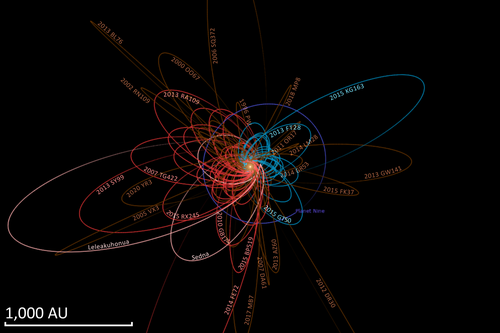 | |
| Discovery [1] | |
|---|---|
| Discovered by | PMO NEO Survey Program |
| Discovery site | Purple Mountain Obs. |
| Discovery date | 6 February 2008 |
| Designations | |
| 2012 DR30 | |
| |
| Orbital characteristics [2] [a] | |
| Epoch 27 April 2019 (JD 2458600.5) | |
| Uncertainty parameter 1 | |
| Observation arc | 14.72 yr (5,375 d) |
| Aphelion | 3192 AU 2049 AU (barycentric) |
| Perihelion | 14.5 AU |
| 1603.44 AU 1032 AU (barycentric) | |
| Eccentricity | 0.9909 |
| 64207 yr 33100 yr (barycentric) | |
| 0.0453° | |
| 0° 0m 0s / day | |
| Inclination | 77.986° |
| 341.48° | |
| ≈ 16 March 2011 [6] | |
| 195.57° | |
| Jupiter MOID | 9.311 AU |
| Saturn MOID | 5.45 AU [1] |
| Uranus MOID | 3.32 AU [1] |
| TJupiter | 0.9860 |
| Physical characteristics | |
| 19.9 [7] | |
| 7.1 [2] [1] | |
(668643) 2012 DR30 is a trans-Neptunian object and centaur with an extremely eccentric orbit that brings it from the inner Oort cloud, the outermost region of the Solar System. It was discovered on 6 February 2008 by astronomers at Purple Mountain Observatory in Nanking, China. [1] It measures approximately 188 kilometers (120 miles) in diameter.



